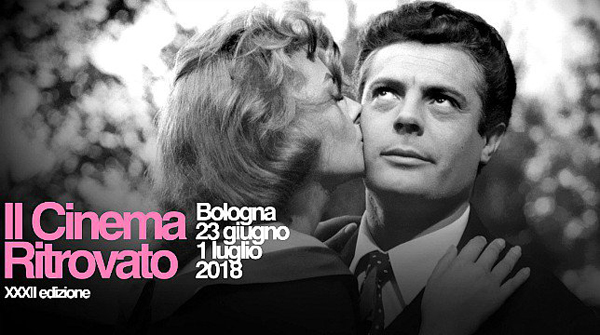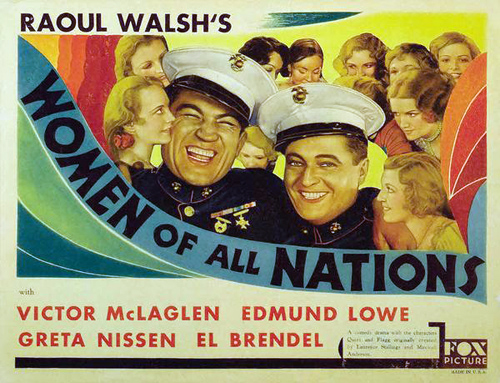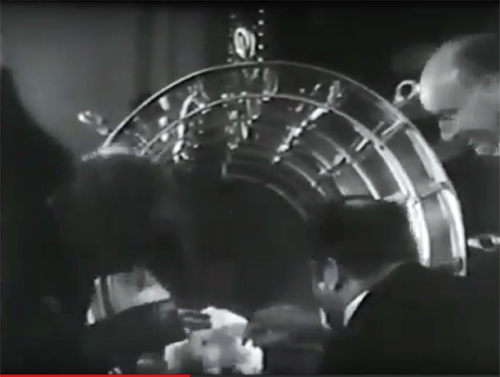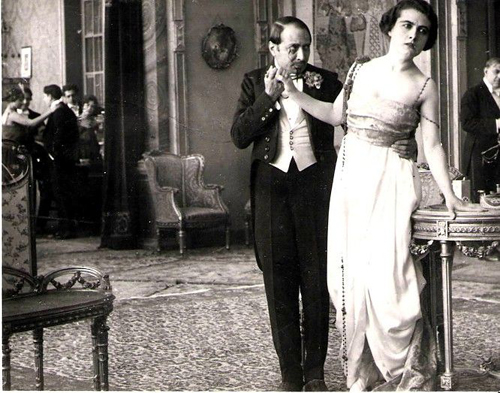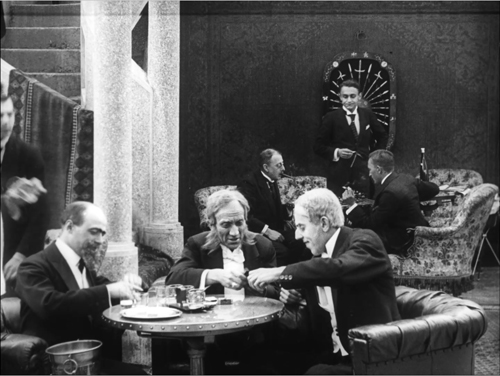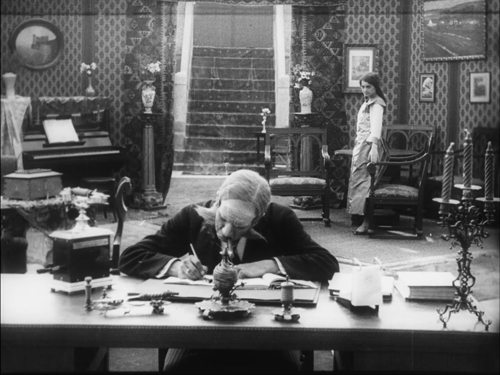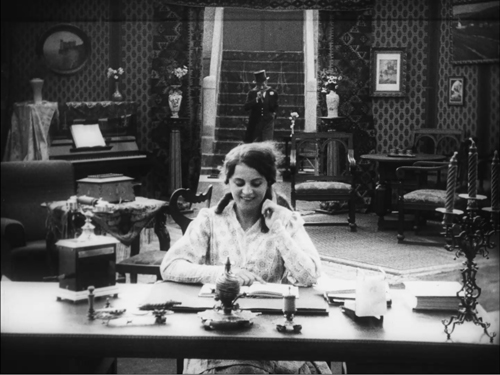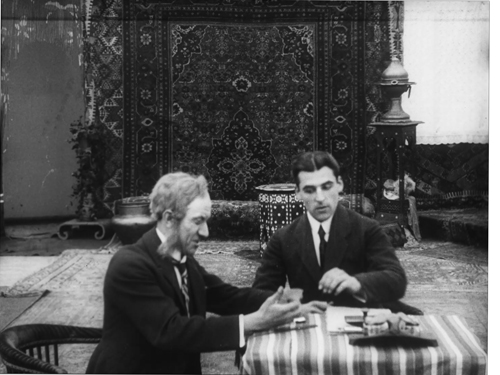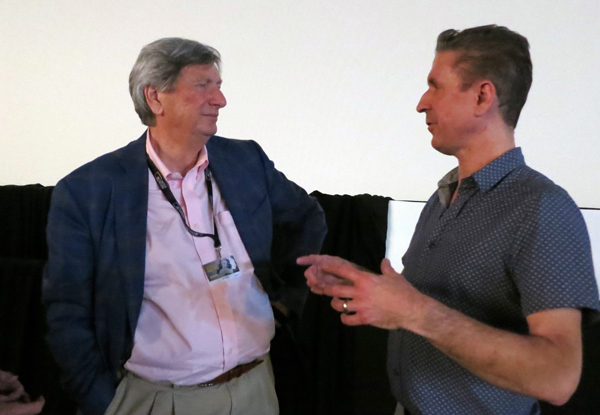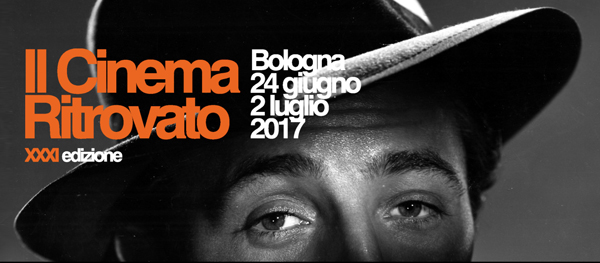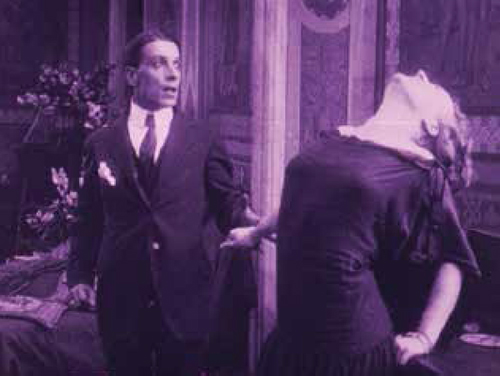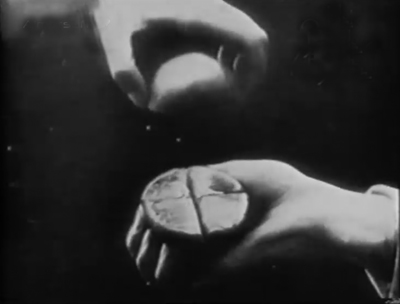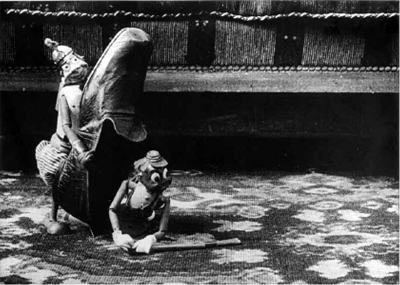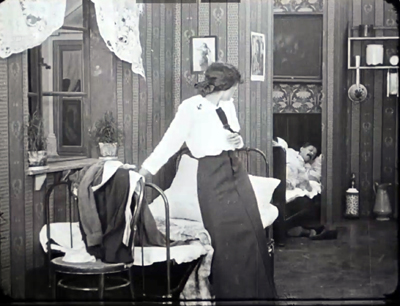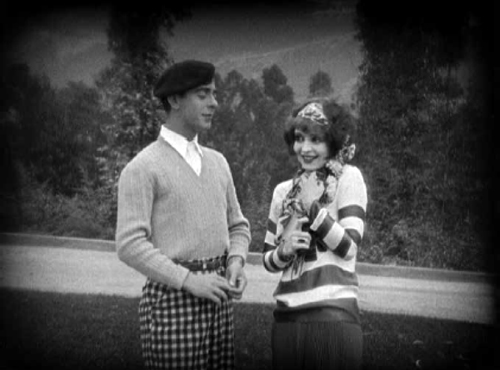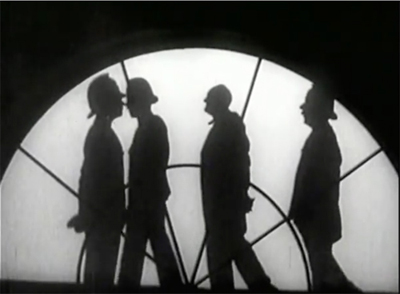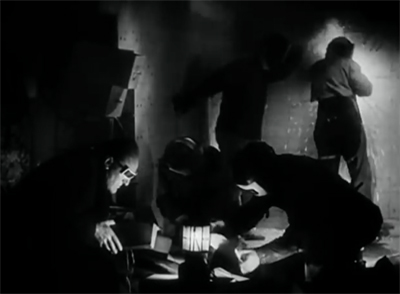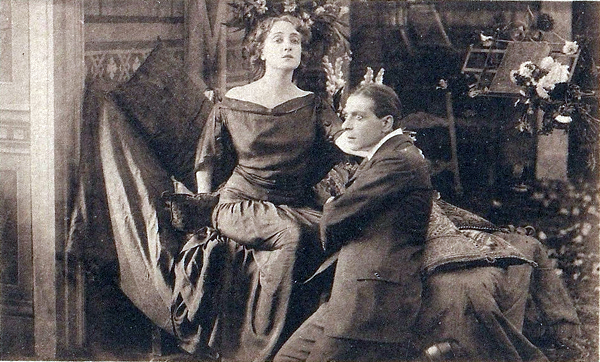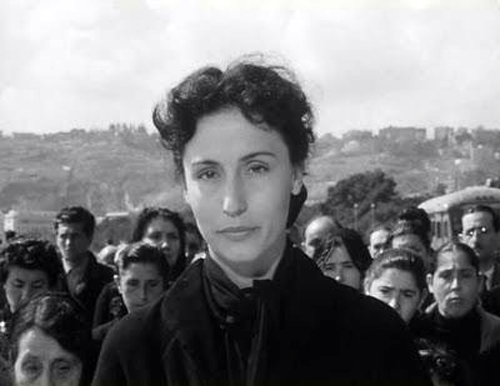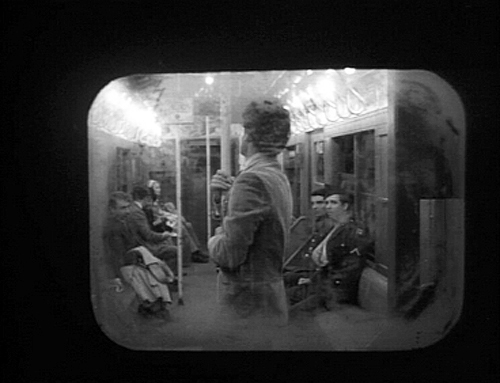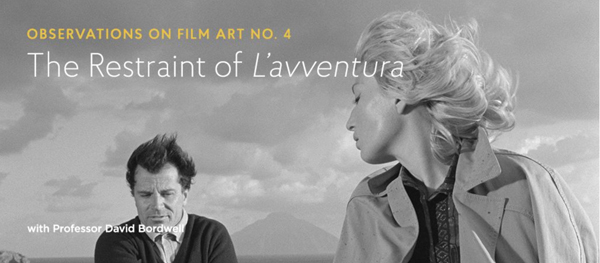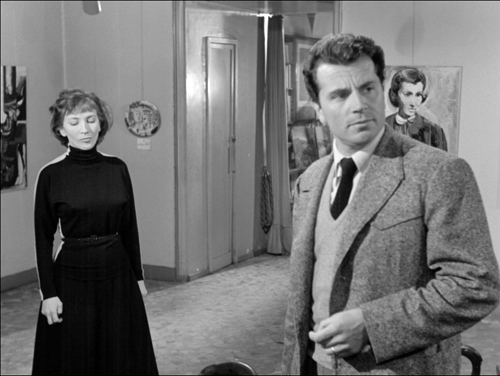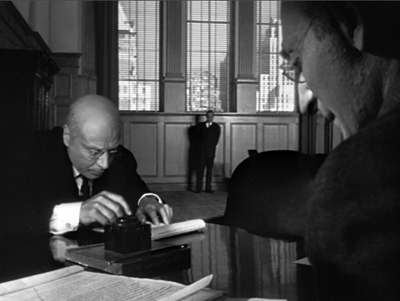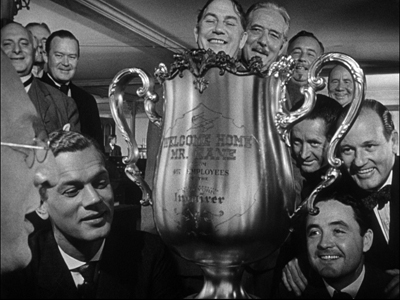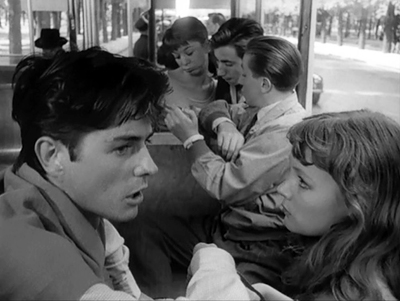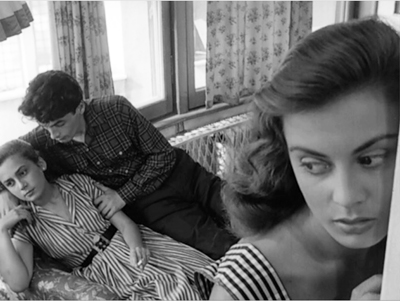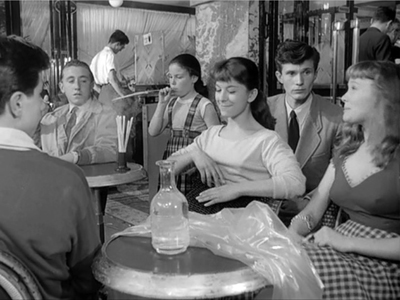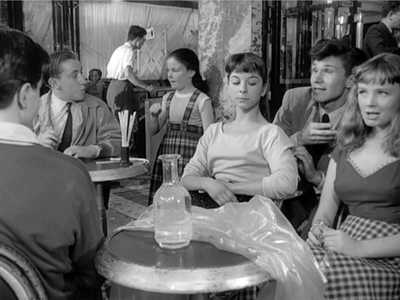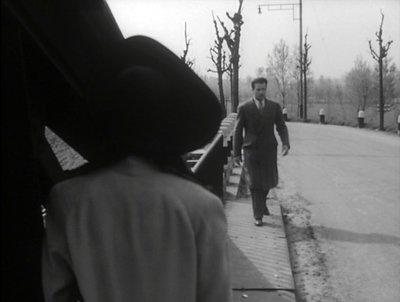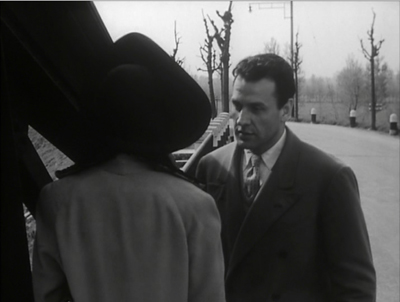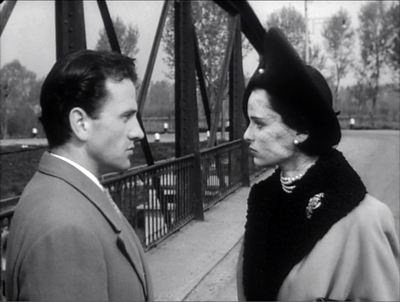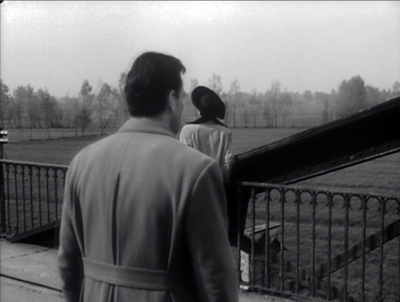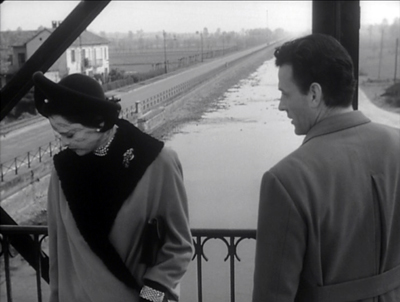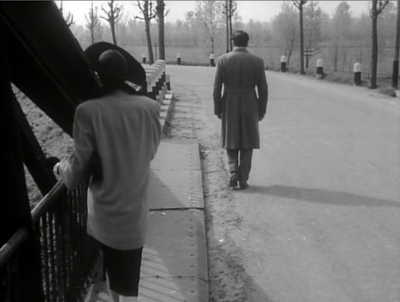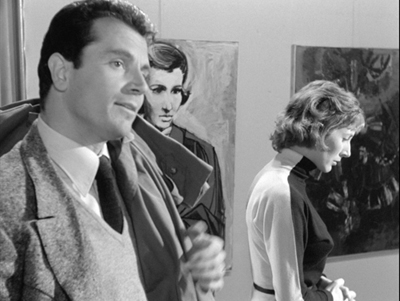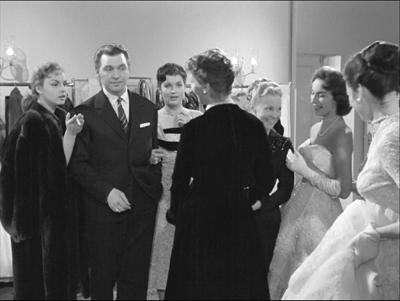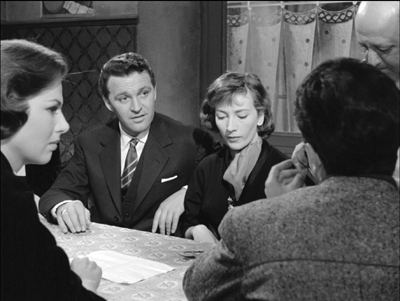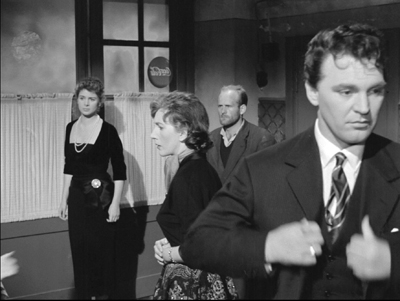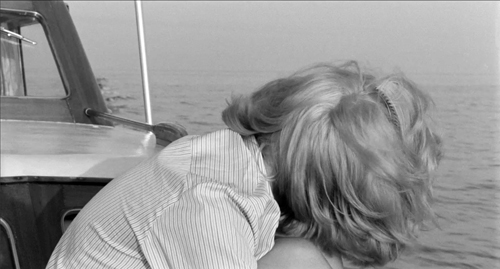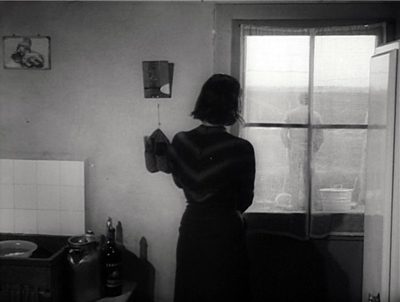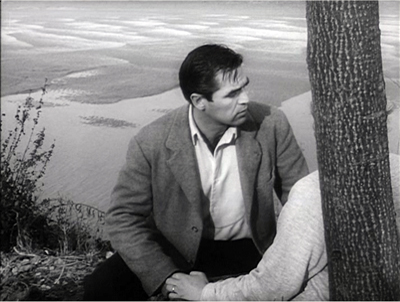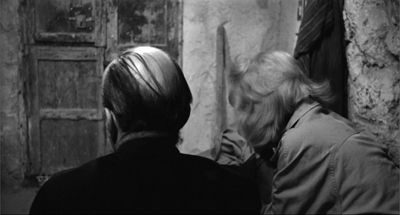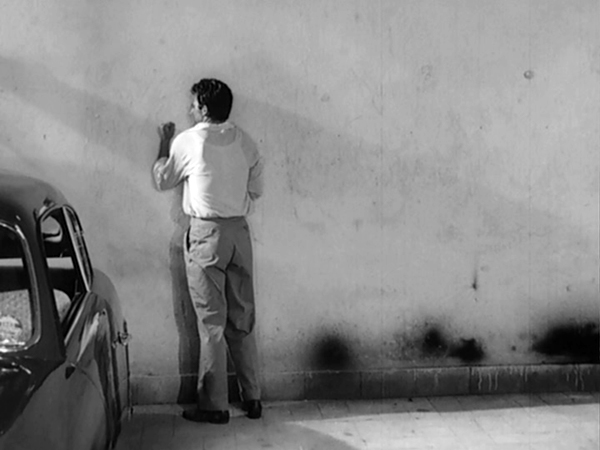Archive for the 'National cinemas: Italy' Category
More Bologna bounty
I think this has become my favorite Ritrovato key image.
DB here:
Cinema Ritrovato rolls on, leaving your obedient servant little time to blog. Herewith some quick impressions on a thin slice of all that’s going on. For a full schedule of this incredible event, go here.
IB or not IB
“Not all IB Tech prints are created equal,” explained Academy Film Archivist (and UW–Madison grad) Mike Pogorzelski. In his last of his annual Technicolor Reference Print shows, he pointed out that Technicolor sent its best-balanced prints to big-city venues and circulated them widely. As a result, they got worn out. The prints most likely to survive were less-than-perfect ones sent to the hinterlands or just kept as backups. Hence the need to preserve the Reference Prints selected by the filmmakers as defining the Technicolor timbre of each film.
With clips ranging from The Godfather and Let It Be to Sssss and Billy Jack, the sample gave a good sense of what Tech looked like a few years before the imbibition (IB) process was abandoned in 1974. Mike and Emily Carman introduced the extracts with informative commentary. I had always thought that Gordon Willis’s cinematography on the Godfather films and The Parallax View increased graininess, and this show seemed to confirm that sense.
Those naughty pre-Code pictures, again
The John Stahl and William Fox retrospectives brought some spicy material. Women of All Nations (1931), Raoul Walsh’s episodic sequel to What Price Glory?, had Quirt and Flagg on the verge of all-out cussing in nearly every scene. A monkey wriggling inside El Brendel’s trousers created moments of good dirty fun. Bachelor’s Affairs (tee-hee, 1932) had Adolph Menjou peering down a golddigger’s front and praising her virtues: “What a charming combination.” She asks if it’s showing. Likewise this repartee: “Were you out last night?” “Not completely.”
William Dieterle’s Germanic Six Hours to Live (1932) begins as a political thriller and devolves into a Twilight Zone fantasy. A representative of a small country passionately protests worldwide tariff legislation. To keep his vote from vetoing the action, spies target him for elimination. Soon enough, he’s throttled to death. But an enterprising scientist takes the opportunity to try out his resuscitation ray, which gives the hero a few more hours to make his mark.
John Seitz photographed the whole farrago in glowing imagery shot through with shafts of blackness, alternately soft-focus and crisply edged. Here’s the magic machine.
The film’s look is an example, I suppose, of what Andrew Sarris once called “Foxphorescence”–the signature of a studio that, from Murnau and Borzage to Ford and 1940s noirs, played host to dazzling pictorial effects.
Not completely naughty, but certainly a film about sexual jealousy, was Seed (1931), one of the most anticipated films of the Stahl cycle. It lived up to its reputation as a masterly orchestration of sympathies. At the center is a love triangle based on two women’s roles: the mother and the businesswoman.
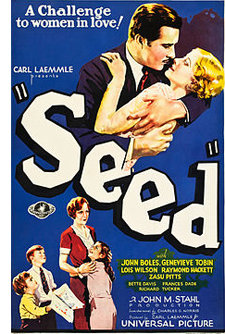 Aspiring author Bart Carter has given up his novel, and he lives–he thinks–happily with his wife Peggy and five rambunctious kids. When his old flame Mildred returns to the publishing firm Bart works for, she encourages him to keep writing and to stray from the household Peggy has made for him.
Aspiring author Bart Carter has given up his novel, and he lives–he thinks–happily with his wife Peggy and five rambunctious kids. When his old flame Mildred returns to the publishing firm Bart works for, she encourages him to keep writing and to stray from the household Peggy has made for him.
As often happens in Hollywood, the plot works only if the man is a jerk, and the action will set up things to make the woman take the blame. Mildred may not have schemed to pull Bart away from the start, but the shift in our sympathy to Peggy is pretty decisive. The film’s patient pace and stringently objective presentation lets contrasting feelings get developed gradually. The kids, particularly the whining runt of the litter, are annoying and troublesome. Mildred is no obvious predator, Peggy is trying valiantly to accommodate Bart’s ambition, and he’s enjoying his vacation from fatherhood while still struggling, albeit weakly, to stay loyal to his family.
Stahl was one of the major long-take directors of 1930s Hollywood, and Seed is exemplary in this respect. (The average shot lasts about twenty seconds.) His back-to-basics two shots, facing off characters in profile, become the default setting; there are scarcely any reverse angles or eyeline matches. This apparently simple creative choice, anticipating Preminger’s method of the 1940s and 1950s, puts all characters on an equal footing. The framings force us to concentrate on their conversation, avoiding the customary cuts that punch up particular lines or reactions. A similar steady observation is at work in Stahl’s fine Imitation of Life (1934) and Magnificent Obsession (1936).
1918 and all that
L’avarizia (1918). Production still.
Regular readers of this blog know that one area of my research is the stylistics of 1910s cinema in various countries. (Check the category tableau staging for a sample.) Naturally I dropped obsessively in on the 100-years-ago strands at this year’s Bologna. While there are more films to come, I found plenty to enjoy and think about in the first few days.
There was, for instance, Der Fall Rosentopf, a fragment of a farcical Lubitsch feature. Ernst plays his Sally character, now a detective investigating a flower-pot mystery. Lively enough, the surviving nineteen minutes from early scenes didn’t give me much sense of the whole.
Alongside it were two other comedies. Gräfin Küchenfee featured Henny Porten in a dual role, both countess and kitchenmaid. When the countess goes off to have fun, the maid assumes her identity. Eventually, the two women switch roles when the countess tries to evade police charges by pretending to be the maid. No less predictable in its comic situation was Puppchen, in which a young woman working in a fashion salon breaks a lifelike mannequin and must take its place. It may have been a model for Lubitsch’s Die Puppe (1919).
Stylistically, all these films were fairly staid, with little intricate staging, and they lacked analytical editing apart from axial cuts in and out. Their reliance on longish takes probably reflected the fact that US films, with their bold continuity editing, weren’t available in Germany until somewhat later.
One American film also rejected the emerging Hollywood style, in the name of naivete and fancy. That was Prunella by Maurice Tourneur. It doesn’t survive complete, and it’s been known for many years as a failed venture into artiness. The flat sets resemble children’s book illustrations, and the performance style is wilfully arch. I’ve never found Prunella very interesting, but it does offer further evidence that the 1910s harbored some eccentric and ambitious experiments.
Gustavo Serena’s L’Avarizia impressed me more. It too relies on frontal acting and axial cutting, but as a vehicle for the great diva Francesca Bertini it seemed to me completely engrossing.
As part of a series illustrating the Seven Deadly Sins, it offers a starkly symmetrical plot. Maria and Luigi love each other, but each is dominated by an old miser. Her aunt and his father each amass a fortune in secret while manipulating the young people. Through a series of conspiracies and misunderstandings, the lovers are flung apart. Maria, friendless and illiterate, sinks down, down into the bottom of society.
Each step of the way is given powerful expression by Bertini’s face, gestures, and bearing. She grabs her hair to yank her head back; she blows cigarette smoke in Luigi’s face to show her contempt for his abandonment of her. At one high point, when Luigi falsely accuses her of infidelity, she wrestles with him on a tabletop, giving no quarter. In a tavern fight she pulls a knife before falling to the floor, writhing feverishly in what appears to be her last moments on earth. This is silent opera, with the soaring melody carried by the body.
Up against the fourth wall
A meeting of the Antifeminist Club (The Oriental Language Teacher).
I wasn’t surprised to find a diva film full of sensuous appeals, but the big revelation of the 1918 cycle so far was the Czech comedy The Oriental Language Teacher (Učitel Orientálních Jazykû). It showed what you could do with a small cast, a few sets, and a cut-and-dried situation.
Sylva secretly falls in love with Algeri, who’s tutoring her in Turkish. After her father is being considered for a diplomatic post in Turkey, he decides to learn the language. He arrives during one of Sylva’s lessons, so she quickly disguises herself as an odalisque. Needless to say, Father is smitten with this exotic beauty. Add in his membership in the Antifeminist Club, led by a comic geezer who enjoys snapping clandestine photos of passing women, and insert deceptions involving a pianola roll, and you have some substantial complications.
Most striking from a pictorial standpoint were the very deep sets–modeled, stylistic historian Radomir Kokes tells me, on the Danish cinema of the period. The co-directors Olga Rautenkransovå and Jan S. Kolár present Sylva’s parlor in an unusual way. Most films of the period put foreground desks and tables at a diagonal bias. But here the father’s desk is thrust very close to us, perpendicular to the camera, and it runs the entire length of the frame.
Moreover, the father is centered at his desk, when the more normal placement would set him to left or right and clear a space in the other half of the frame for other characters. The depth, that is, is typically horizontal. Here, though, it’s also vertical. A character must descend the stair directly above the other, in a maniacally centered composition that’s mildly beguiling in itself.
The set depicting Algeri’s studio is a little more typical of the period, since his desk is placed off to one side, but every shot of this setup makes the foreground area curiously out of focus.
Given that the control of focus is precise in the parlor shots, the slightly fuzzy foreground of the studio set remains anomalous–an error, or a decision to differentiate the two spaces more sharply. In any case, here’s another example of how 1910s movies, from all corners of the world, can set you thinking about the possibilities of pictorial design.
More to come in the next entry, with a special focus on trial films.
Special thanks to Radomir Kokes for help with this entry. More generally, thanks to the Bologna leaders and staff for a tightly-run and ever-exciting event, along with the archivists who made these films available. In particular we owe a lot to Marianne Lewinsky, who curates the Cento Anni Fa series, and to Dave Kehr who, grinning, shares what he called on the first day MoMA’s “mildly obscure” treats. And Imogen Sara Smith gave an exceptionally lucid introduction to Seed.
For more on diva acting, see Ben Brewster and Lea Jacobs, Theatre to Cinema, a book available here, and this entry by Lea on Bertini. Kristin wrote about Prunella and other mildly experimental Hollywood films in Jan-Christopher Horak’s Lovers of Cinema collection.
For more on-the-spot pictures, check our new Instagram page.
John Bailey, President of the Academy of Motion Picture Arts and Sciences, and Michael Pogorzelski.
Ritrovato 2017: Drinking from the firehose
DB here:
Immense scale and teeming activity are nothing new to Il Cinema Ritrovato, the Cineteca di Bologna’s annual jamboree of restored and rediscovered films from all over the world. The scorching heat–90 degrees and more for the first few days–only makes it seem more intense than usual.
Kristin and I had to miss the last Ritrovato session, but we’re convinced that this nine days’ wonder is still the film-history equivalent of Cannes.
In one way, your choice is simple. You can follow one or two threads–say, the Robert Mitchum retrospective or the Collette and cinema one or the classic Mexican one, or whatever–and dig deep into that. Or you can skip among many, sampling several, smorgasbord-style.
In practice, I think most Ritrovatoians pursue a mixed strategy. Settle down one day for a string of, say, early Universal talkies and another day check out the restored color items. On off-days roam freely. The problem is you will always, always miss something you would otherwise kill to see.
At the start, I plumped for 1910s films, particularly Mariann Lewinsky’s reliable 100 Years Ago cycle. My other must was the Japanese films from the 1930s; half of the titles brought by Alexander Jacoby and Johan Nordström, were new to me. As of this writing, I haven’t seen those, but I have dug into the 1917 items. And I indulged myself with, no surprise, some gorgeous Hollywood things.
1917 and all that
Malombra (1917).
If you caught any of my dispatches from Washington DC earlier this year (starting here) you know I was burrowing deep into American features of the 1910s That complemented several years of archival work on European films of the same period. So of course the chance to sample 1917 features from Hungary, Poland, Russia, and elsewhere was not to be passed up.
Some superb ‘teens films I just skipped through familiarity. Gance’s Mater Dolorosa (1917), possibly the most patriarchal film in the thread, remains tremendously inventive at the level of silhouette lighting and continuity cutting (a huge variety of camera setups during the fatal love tryst). And one of the very greatest directors of the period, Yegenii Bauer, was represented by two of his last films, The Revolutionary and Towards Happiness. I’ve studied both elsewhere, in On the History of Film Style, Figures Traced in Light, and online. Even so, I found plenty to keep me busy.
One of the main threads was devoted to Augusto Genina, a director with an astonishingly long and prolific career. Probably best known for Prix de Beauté (Miss Europe, 1930), he started in 1913 and made his last film in 1955. His 1910s films confirm that Italy was producing many films of striking beauty and audacity in those years.
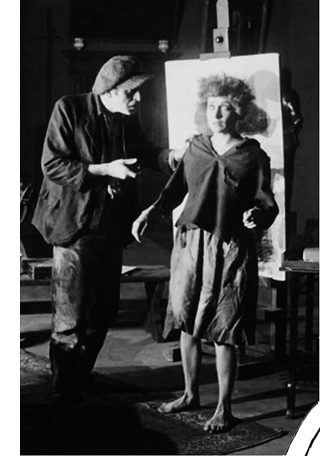 Take Lucciola (1917, right), the story of a waif who befriends a harbor layabout but leaves him to become a society princess admired by a debonair painter and three bulbous plutocrats. Pivoting from social satire to low-life melodrama, the film makes use of bold lighting and meticulous cutting, usually along the lens axis. (Like many European films of the ‘teens, Lucciola lies sort of between tableau cinema and the faster-cut American style.) All in all, a strong, tight movie.
Take Lucciola (1917, right), the story of a waif who befriends a harbor layabout but leaves him to become a society princess admired by a debonair painter and three bulbous plutocrats. Pivoting from social satire to low-life melodrama, the film makes use of bold lighting and meticulous cutting, usually along the lens axis. (Like many European films of the ‘teens, Lucciola lies sort of between tableau cinema and the faster-cut American style.) All in all, a strong, tight movie.
In a similar vein is Addio, Giovenezza! (1918), adapted from a popular song. This one, screened in an open-air venue thanks to an arc-lamp projector, is another sad Genina tale. A careerist law student abandons his rooming-house maid for a social butterfly with a wardrobe to die for. Apart from one startling scene in a milliner’s shop, illuminated mostly by spill from the street, the lighting isn’t as daring as in Lucciola. Still, the poignant plot is again inflected by comic touches, proceeding largely from the hero’s nerdish fellow student. Genina redid the story again in 1927, and I’m hoping to catch that screening.
Malombra (1917), starring the diva Lyda Borelli, was by the great Carmine Gallone. (I’ve discussed La Donna nuda and Maman poupée hereabouts.) After moving into a castle, Marina becomes possessed by the spirit of the woman who died there. Our heroine’s job is to take revenge on the faithless husband. Flirtatious and iron-willed, Borelli dominates her scenes with shifts of stance, sudden freezes, rapid changes of expression, languorous arm movements, and, at one climax, a swift undoing of her hair that lets it all tumble wildly around her face. The print, needless to say, was superb.
In a lighter vein, if you wanted proof of the inventiveness of ‘teens Italian film, you couldn’t do better than Wives and Oranges (Le Mogli e le arance; 1917). This agreeably silly movie sends a bored young man to a spa populated by incredibly aged parents and a bevy of scampering daughters. With an avuncular friend, Marcello capers with the girls before settling on the most modest one as his wife. But her friends aren’t disappointed because our hero’s pals come for a visit and get roped into matrimony too.
Wives and Oranges has a remarkable freedom of narration. The film uses montage sequences with a fluidity that is rare at the time. To convey the boredom of Marcello’s daily routine, a string of quick shots is punctuated by changing clock faces. Later, the idea of finding one’s ideal love mate by matching halves of oranges is presented via an absurd montage of old folks, youngsters, babies, and just abstract hands, all wielding oranges.
Marcello’s paralyzing dilemma of choice is given as a nondiegetic insert of a donkey unable to decide between a hay bale and a bucket of water. These flashy devices keep us interested in a situation that, in script terms, is probably stretched too thin–although when things slow down you can count on the daughters forming a chorus line and zigzagging down the road or popping out from under the dinner table one by one.
Almost as lightweight was The War and Momi’s Dream (La Guerra e il sogno di Momi, 1917), by the great Segundo de Chomón, who moved among France, Spain, and Italy making fantasy films of many types. This one is largely meticulous puppet animation, in which a boy’s toys come to life and enact–at the height of the World War–their own combat.
Trick and Track marshall other toys to play out some seriocomic clashes, including a burning farmhouse and one astonishing shot of an entire town landscape, covered in a long camera movement. Again, there’s no underestimating the sheer technical audacity of Italian cinema of these days.
There’s always an exception, of course. The late David Shepard left us, among much else, Shepard’s Law of Film Survival: The better the print, the worse the movie. A good example is La Tragica fine di Caligula Imperator (1917), signed by Ugo Falena. It’s surprisingly retrograde for an Italian film of the period. Neither the staging (flat, distant) nor the cutting (minimal) nor the lighting (little modeling) is much in tune with contemporary norms. The problem may be the immense sets, which are indeed impressive but which seem to encourage the actors to a hard-sell technique.
The most amped-up is Caligula himself. Playing a mad Roman emperor often tempts any actor to gnaw table legs. But as an example of what a silent film really could look like, Caligula should be required viewing for anybody who sneers at Those Old Movies. If Christopher Nolan saw it, he’d demand to shoot on orthochrome nitrate.
Other 1917 features included The Soldier on Leave, from Hungary, and Stop Shedding Blood!, by the great Russian director Jakov Protazanov. The former was restored from a 17.5mm copy, the latter was missing the two central reels. The Protazanov in particular had some sharp staging in depth and rich sets.
In the same batch was Pola Negri’s screen debut in Bestia (1917, imported to the US as The Polish Dancer). In a fine copy, you could appreciate the bouncy but sultry screen presence that made her a star. And as often happens with films from anywhere in this period, the sets sometimes play peekaboo with the action. Pola, after a night out with her thuggish lover, sneaks back to her bed while her father snores in the background, caught in a slice of space.
Back in the USA
Kid Boots (1917).
The 1917 American entry was a strong, unpretentious Western by Frank Borzage, Until They Get Me. It’s missing some scenes in the middle, but it remains a forcefully quiet movie. The only gunplay takes place at the start, when a man racing to get to his wife in childbirth is forced into a gunfight. He kills the drunkard who provoked it, but by the time he reaches his home, his wife is dead. Now he must flee Selwyn, a mountie. Stealing a horse, he picks up an orphan girl fleeing an oppressive household. The rest of the film will intertwine the fates of the three, leading to a surprisingly civilized resolution.
Borzage is one of the many great directors–De Mille, Dwan, Walsh, Ford, Brown, King, Barker–who started doing features in the mid-teens. Most had long careers. They mastered the emerging norms of Hollywood continuity cinema and learned to deploy them with tact and precision. Just the timing of the reaction shots in Until They Get Me is worth study.
Frank Tuttle started in features a bit later, in 1922, but Kid Boots (1926), my first movie of the Ritrovato, showed complete mastery of comic storytelling. Eddie Cantor, a fired tailor, becomes amanuensis to Tom Sterling, a man-about-town in the throes of a divorce. The twist is that his wife, learning of Tom’s new inheritance, wants to halt the divorce by sharing his bed again. Eddie’s job is to keep the wife and the lawyers at bay until the divorce becomes final. Into this tangle plops perky Clara Bow in her first film after her breakout role in Mantrap (also 1926). You could watch her cock her chin and roll her eyes for hours. She steals the picture from Billie Dove.
The gag situations come thick and fast, with one high point being Eddie’s efforts to get Clara jealous by recruiting a strategically open door to help him pretend that his left arm actually belongs to Tom’s seductive wife. The whole thing culminates in a breathless chase on horses along a treacherous mountain pass. Eddie and all the others keep things lively, and Tuttle’s direction is exacting.
I strayed from the ‘teens again at Dave Kehr’s urging. Of Dave’s magnificent MoMA restorations, I caught William K. Howard’s Sherlock Holmes (1932). Apart from a wild-eyed Ernest Thesiger and an imperturbable Clive Brook, it boasts an abstract opening of silhouettes and confrontational close-ups and a conclusion of percussive flashes as Moriarty’s gang torches its way into a bank.
Ace cinematographer George Barnes had a field day with this one.
That was followed by Tay Garnett’s Destination Unknown (1933), a tense drama of a crisis on a bootlegging ship immobile on a windless sea. Hard, fast playing by Pat O’Brien and Alan Hale was offset by the leisurely presence of none other than Ralph Bellamy, aka Jesus of Nazareth. Don’t ask; just see it.
More from me, and Kristin, later in the week.
Thanks to Guy Borlée for a great deal of assistance on this entry. Thanks as well to the programmers and staff of the festival, especially Gian Luca Farinelli and Mariann Lewinsky.
The Ritrovato site is constantly updated. For our earlier Ritrovato communiqués, go here.
Malombra (1917; production still).
Wisconsin Film Festival: Retro-mania
The Gold of Naples (L’oro di Napoli, 1954).
DB here:
With the growing popularity of subscription streaming services, I suspect that film festivals will need to amp up their retrospective offerings. I was very surprised that a good film like I Don’t Feel at Home in This World Anymore, which would in earlier years have played arthouses, had no theatrical release. Despite its acclaim at Sundance, it went straight to Netflix online. True, Amazon has shown great willingness to port its high-profile titles to big screens. But by and large, as Netflix, Amazon, and other services produce and buy up new films, I suspect that festival premieres of indie titles will become more and more a display case for streaming. See it this week at our festival, and next month online!
It must be dispiriting for filmmakers hoping for theatrical play. Yet this crunch may oblige festival programmers to emphasize archival and studio restorations. These rarities are unlikely to show up on streaming any time soon, and festival screenings can build a public for them—so that they may eventually come to DVD or subscription services.
Case in point: Several restored titles at our Wisconsin Film Festival drew sellout crowds.
AMPAS comes through
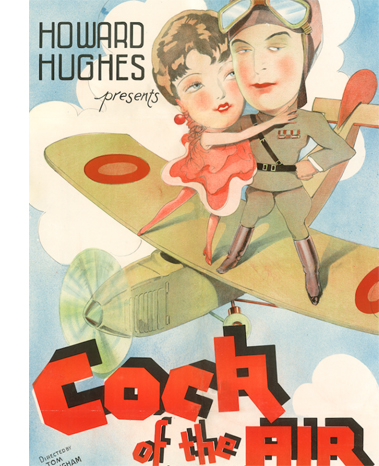 To my regret, I didn’t catch the Academy Film Archive restoration Across the World and Back, a collection of global adventures of “the world’s most traveled girl,” the self-named Aloha Wanderwell. Her 1920s and 1930s footage, which included record of the Taj Mahal and the Valley of the Kings, was introduced and commented on by Academy archivist Heather Linville. Everybody I talked to loved it. Go to AMPAS for many clips and pictures.
To my regret, I didn’t catch the Academy Film Archive restoration Across the World and Back, a collection of global adventures of “the world’s most traveled girl,” the self-named Aloha Wanderwell. Her 1920s and 1930s footage, which included record of the Taj Mahal and the Valley of the Kings, was introduced and commented on by Academy archivist Heather Linville. Everybody I talked to loved it. Go to AMPAS for many clips and pictures.
I did manage to squeeze into another Academy restoration, Howard Hughes’ Cock of the Air (1932). The film amply showcases Hughes’ two principal concerns, aviation and the female mammary glands. (I guess technically that makes three concerns.) It’s a minor-key Lubitsch switch in which priapic flyboy Chester Morris pursues sexy Billie Dove, who’s resolved to bring his ego crashing to earth. We get lots of nuzzling, murmured double entendres, and scenes of passion quickly doused by the woman’s coquettish withdrawal. I thought the plot thin, needing a romantic rival or two, but the leering pre-Code stuff is good dirty fun. The high point comes when Billie encases herself in a suit of armor and Chester arms himself with a can opener.
The direction is credited to Tom Buckingham, a lower-tier artisan, but it seems possible that parts of the film were handled by Lewis Milestone, who contributed the original story. The first couple of reels are very flashy, with odd angles, complicated tracking shots, and bursts of rhythmic editing. They’re typical of Milestone’s showy, sometimes showoffish, style in All Quiet on the Western Front (1930) and The Front Page (1931; also shown at WFF).
Cock of the Air encountered heavy censorship, with the can-opener episode entirely snipped from the release version. The Hays Office even provided local censor boards with guidance for further cutting. When Heather discovered a pre-censorship print at the Academy—an exciting find—she discovered that the offending footage was there, but the soundtrack portions were lost.
Heather proceeded to hire actors to voice the parts in accord with the script and the onscreen lip movements. The results are sonically smooth, but in the spirit of fair dealing, the bits of replacement are marked with a discreet bug in the lower right corner of the frame. This is a nice piece of archival integrity. Heather also showed an informative short on the restoration of this engaging piece of naughty early sound cinema.
Of incidents and non-incidents
The Incident (1967).
Two other pieces of film history got fitted into place with the revival of Larry Peerce’s One Potato, Two Potato (1964), a classic of American social-problem cinema, and the rarer The Incident (1967). This latter glimpse of mean streets creates what screenwriter David Koepp calls a Bottle, a tightly constrained space in which the drama plays out. Here the Bottle is a subway car in which several people, a cross-section of New York life, become the playthings of two young thugs, played by Tony Musante and Martin Sheen.
Starting by gay-bashing and culminating in a charged racial confrontation, the subway conflicts sought to show how the solid citizens can’t summon the will to respond collectively—even when they take their turn under the thugs’ lash. It was intended as a response to the infamous murder of Kitty Genovese, whose screams were mostly ignored by her Queens neighbors. (A recent documentary, The Witness, revisits the case.)
 The plot is provocative enough, but the manner of filming, evocative of cinéma-vérité, drives every moment home. Forbidden to film on the subway system, director Larry Peerce and ace cinematographer Gerald Hirschfeld (Cotton Comes to Harlem, Young Frankenstein) had to rely on sets, except for shots snatched with hidden cameras. But what a set they had for the subway car. Peerce explained in an energetic Q & A that the car was built to five-sixth scale, with no wild walls. It forced the players to interact in a cramped, pressurized atmosphere.
The plot is provocative enough, but the manner of filming, evocative of cinéma-vérité, drives every moment home. Forbidden to film on the subway system, director Larry Peerce and ace cinematographer Gerald Hirschfeld (Cotton Comes to Harlem, Young Frankenstein) had to rely on sets, except for shots snatched with hidden cameras. But what a set they had for the subway car. Peerce explained in an energetic Q & A that the car was built to five-sixth scale, with no wild walls. It forced the players to interact in a cramped, pressurized atmosphere.
A believer in improvisation, Peerce rehearsed different groups of actors separately, then brought them together to let some natural friction emerge. He encouraged them to add to the script and build immediate reactions—so immediate that Thelma Ritter, a veteran unused to improv methods, responded to Musante’s goadings by slapping him. All this is captured in a superheated style of fast cuts, big close-ups, and screeching sound. It’s a white-knuckle ride that retains its power. I hadn’t seen it since 1970, but the violent climax, utterly earned, is disturbingly contemporary. The film’s final moments are being replayed, in reality, all over America as you read this.
The nicest surprise of my retrospective viewing was The Gold of Naples (1954). Studded with big names (Ponti and De Laurentiis, Totó and de Sica, Silvana Mangano and Sophia Loren), it has sometimes been thought to be one of those lightweight Italian comedies that represent a quiet refusal of the Neorealist impulse. On the contrary, it proves to be a bold contribution to block construction, here in the omnibus genre. Several stories are laid end to end, exemplifying the vivacity and poignancy of life in Naples’ back alleys.
One story has a tight, shocking arc: the tale of a prostitute (Mangano) who thinks she’s marrying for love until she learns her new husband’s guilt-ridden sadomasochistic motives. The finale is a scrappy anecdote, in which The People give a local plutocrat the ultimate vocalization of disrespect.
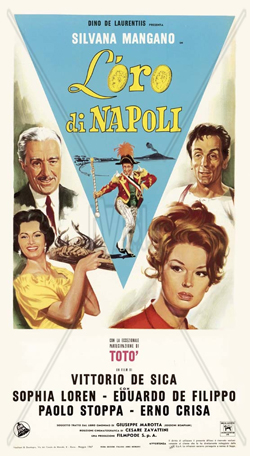 But some episodes, taken as conventional stories, are oddly off-center. A wife (Loren, bursting out of her blouse and skirt) has lost a ring in a torrid encounter with her lover. She finds it again, and no harm done. The search for it is a pretext for sampling other lives. Or: A penniless count addicted to gambling is reduced to playing cards with an exceptionally lucky neighborhood kid. He learns no lesson, the kid is bored with winning, and all is as before. More disquieting: A family bullied by a rich man who has moved in with them finds a way to kick him out, but there’s little sense of triumph. He remains unbowed, and manages to spoil their celebration of his eviction. Most scripts would let us enjoy his comeuppance, but here we’re left with the cowering family, which has become so unused to freedom that they may not know what to do next.
But some episodes, taken as conventional stories, are oddly off-center. A wife (Loren, bursting out of her blouse and skirt) has lost a ring in a torrid encounter with her lover. She finds it again, and no harm done. The search for it is a pretext for sampling other lives. Or: A penniless count addicted to gambling is reduced to playing cards with an exceptionally lucky neighborhood kid. He learns no lesson, the kid is bored with winning, and all is as before. More disquieting: A family bullied by a rich man who has moved in with them finds a way to kick him out, but there’s little sense of triumph. He remains unbowed, and manages to spoil their celebration of his eviction. Most scripts would let us enjoy his comeuppance, but here we’re left with the cowering family, which has become so unused to freedom that they may not know what to do next.
Above all, in an episode cut from the original American release (and missing from this poster, though at the top of today’s entry), a mother follows her son’s coffin driven through the street. She throws wrapped candies for children to pick up. That’s it. No flashbacks to life with her boy, no dialogue telling us how he died, no colorful secondary characters to provide that life-goes-on final note. It could be called “The Incident,” though nothing more unlike the fever-pitch drama of Larry Peerce’s film could be imagined.
According to screenwriter Cesare Zavattini, a Hollywood producer once told him:
“This is how we would imagine a scene with an aeroplane. The plane passes by. . . a machine gun fires . . . the plane crashes. And this is how you would imagine it. The plane passes by. . . The plane passes by again… The plane passes by once more…”
He was right. But we have still not gone far enough. It is not enough to make the aeroplane pass by three times; we must make it pass by twenty times.
And, Zavattini seems to suggest, the machine gun should never fire.
The lack of a dramatic peak, to which a normal scene would build, can force our attention to downshift to the minutiae of moment-by-moment action, or rather micro-action. That’s what happens in this sequence of The Gold of Naples, which Zavattini helped write. Every gesture and glance becomes potentially, but ambiguously, significant. De Sica’s patient recording of a very thin slice of life is as radiantly unpretentious a model of “pure Neorealism” as anything to come from the 1940s.
This is just a glimpse of the delights among the 150 screenings that are gracing our eight-day film festival. (We’re now the largest university-sponsored festival in the country, though probably not in budget.) Details of this magnificently programmed affair are here. We’ll blog again soon.
Thanks to the programmers Jim Healy, Ben Reiser, and Mike King, along with all the institutions, wise elders, community supporters, and volunteers that make WFF fun. You can browse earlier reportage from this event here.
You can also see the restored Front Page (1931) in Criterion’s new His Girl Friday DVD release. On Cock of the Air’s censorship travails, see the AFI site. It will be screened very soon at the TCM Festival. Also set for the TCM festival is The Incident, which will screen later in April at Film Forum. Mike Mashon gives more information on Aloha Wanderwell in his LoC blog.
How wrong I was to miss booking The Gold of Naples when I ran a film club in college and good old Audio-Brandon offered it. Even without the funeral scene and the up-yours finale, it would be worth seeing. Now no version seems available in the US; WFF director Jim Healy brought a print from Italy. It would be perfect for FilmStruck.
Read…watch movie…grab food…read…watch movie…
Going inside by staying outside: L’AVVENTURA on the Criterion Channel
DB here:
This month, our entry on FilmStruck’s Criterion Channel is a discussion of L’Avventura. This isn’t my favorite Antonioni movie, but it’s one I enjoy and admire—not least because of its striking originality of mise-en-scene. So that’s what I tackle in the Criterion entry.
The installment is here, and if you’re a subscriber you can watch it immediately. Otherwise, there’s a chance to sign up. If you’re not aware of FilmStruck, one of the great adventures in modern film culture, you can check on it here. (The Twitter feed is enjoyable even to non-tweeters like me.) Today, I want to flesh out my entry with some other comments. I hope they’ll be of interest even to those who aren’t signed on to the FilmStruck enterprise.
Two ways of doing deep
Le Amiche (1955).
During the 1950s, Antonioni displayed vigorous experimentation in visual style. Like many directors, he embraced the long take, usually in conjunction with camera movement. Within those parameters, he staged his action both laterally and in depth. But depth staging comes in many flavors.
One is the aggressive deep-focus technique of Welles, with large heads or objects very close to the camera in the foreground. Here are two famous instances from Citizen Kane (1941).
This fairly extreme approach was picked up by some 40s and 50s directors, especially those interested in what came to be called film noir.
You can find somewhat mild versions of these compositions in early Antonioni, especially in cramped surroundings. A bus ride and a necking party in I Vinti (1953) bring forth some big foregrounds.
Despite occasional shots like these, Antonioni’s early work favors an alternative approach to depth, the one cultivated by Jean Renoir, Mizoguchi Kenji, William Wyler, and others. That approach doesn’t go for Citizen Kane baroque. It keeps the foreground plane fairly distant–say a medium-shot or further–and uses both lateral and fairly deep staging to multiply key points of interest in the shot. Less fancy than the Welles tradition, it allows more naturalistic blocking because it yields more playing space.
Go back to I Vinti, and we’ll find that most shots aren’t as thrusting as Welles’ images, largely because of their reliance on real locations and naturalistic lighting. The film tends to stages its long takes in mid-range, porous compositions. A two-minute shot of teenagers lounging at a cafe and plotting a murder is rendered in a gentle diagonal that spreads out multiple points of interest.
By the way: Why doesn’t anybody make shots like this any more?
One advantage is that while the packed Wellesian frame tends to make its actors assume fixed poses, the more open frames of the alternative can show more of actors’ bodies and develop gestures and other actorly bits. This happens in the I Vinti café scene, which depends on characters’ changing postures, along with the distraction of the annoying little girl blowing on drink straws.
Similarly, Antonioni’s first feature, the noirish romance Story of a Love Affair (1950) makes adroit use of the mid-range foreground. The famous single-shot, 360-rdegree scene between lovers quarreling on a bridge is a paradigm case of how location filming can be made rigorous and purposeful. A complex camera camera movement is coordinated with figures resolutely evading each other in constantly varied medium-shots.
Le Amiche (1955) continues down the same path, with characters alotted distinct pockets of the frame to expose their fleeting reactions.
But there’s now a more intricate choreography, as befits a plot with several story lines. A scene gathering the major characters at a cafe is a magnificent exercise in the Wyler manner, with heads meticulously spotted across the frame.
For years I was surprised that L’Avventura (1960) and its successors La Notte (1961) and L’Eclisse (1962) make less use of this sort of precise staging in depth. While the director’s style remains fluid and rigorously patterned, and powerfully exploits urban vistas, it relies more on editing. But looking again at L’Avventura for the Criterion Channel installment, I became convinced that he was exploring a new way to handle staging—one that built upon his mastery of Renoir-Wyler choreography.
From the back or from the front
When a film’s narrative harbors mysteries, they’re often a matter of plot. Something has happened that we don’t fully know about, and the business of the plot is to bring that to light, either in the short term or across the whole movie. In the detective film, there’s a mysterious crime that needs solving, and the clarification will typically come at the climax, when the malefactor (and the motive, and the means) will get revealed. Plot-centered mysteries are easily dismissed as superficial, but the great tradition of literary detection shows that they can be imaginative and gripping, while also exploring literary techniques in sophisticated ways.
There are also mysteries of character—not just whodunit, but something deeper. A narrative might induce us to ask what makes characters do what they do. This can result in fairly superficial probing, as in many psychoanalytic films of the 1940s, but it can, again, prod the storyteller to exploit some aspects of the medium that engage us. At the limit, mysteries of character can lead the narrative to explore the moods and motives of its people, bringing out contradictions of mind and action. Even a potboiler like Gone Girl not only reveals the rage bubbling beneath Amy’s perfect porcelain surface but explains that anger as a response to the Cool Girl role dictated by yuppie culture.
I usually don’t employ the distinction plot vs. character when I’m thinking about film narratives, but as a first approximation it points up the nuances of L’Avventura’s visual strategies. The film has, initially, a clear-cut plot-based mystery: What has led Anna to disappear? Is she dead, or lost, or simply escaping from the situation? This is, in a way, the bait luring us to pursue mysteries of character.
What, to start, does Anna want from her affair with Sandro? She seems alternately flirtatious, cynical, angry, and passionate. And assuming her disappearance wasn’t accidental, what impelled her to leave the party? As for Sandro, what sort of man is he? And why does he, with unseemly haste after Anna’s vanishing, seize Claudia and kiss her violently?
Claudia, for her part, seems to gradually accept her role as the Anna substitute. We’d expect her to be torn by her betrayal of her friend, and maybe she is, but we can’t be sure. With almost no backstory supplied for these people and no plunge into their inner lives through dreams, voice-over, subjective visions, and the like, we’re forced to read their minds and hearts on the basis of what they say and do. This is relentlessly behaviorist cinema.
Here’s where visual style kicks in, I think. Antonioni declared his interest in moving the Neorealist impulse from social observation to psychological revelation.
The neorealism of the postwar period, when reality was what it was, so intensely present, focused on the relationship between characters and reality. What was important was that very relationship, which created a cinema based on “situations.” . . . That’s why, nowadays it’s no longer important to make a film about a man whose bicycle has been stolen. . . . It is important to see what is inside this man whose bicycle was stolen, what are his thoughts, what are his feelings.
How to achieve this psychological penetration? Not through the sort of definite scene structure of a Hollywood film, a crisp slice of action that can be summed up in a story beat.
I believe it is much more cinematic to try and capture the thoughts of a person through an ordinary visual reaction, rather than enclose them in a sentence. . . . One of my concerns in filming is to follow the characters until I feel it is time to stop. . . When all has been said, when the main scene is over, there are less important moments; and to me, it seems worthwhile to show the character right in these moments, from the back or the front, focusing on a gesture, on an attitude.
Antonioni scenes, critics sometimes say, begin a bit before they start and end a bit after they stop.
You might expect from this emphasis on character psychology and the habit of lingering on a scene’s resonance would yield few mysteries. Yet what interests me in L’Avventura is the way in which it doesn’t allow us to “see what is inside” its characters. Perversely, having braked the dramatic momentum in order to probe character, Antonioni goes on to block our access to his people’s minds.
His visual strategies for doing this are many, and they’re flaunted in the film made just before L’Avventura. The witholding of character reaction is flamboyant in Il Grido (1957), maybe over the top.
L’Avventura‘s reticent pictorial strategies are more nuanced and naturalistic, and my FilmStruck contribution tries to chart them. For about the first hour of the film, Antonioni lets landscape overwhelms his characters, gives them equivocal facial expressions, refuses the full information of shot/reverse shot cutting, and at crucial moments simply makes his actors turn from the camera, denying us access to their emotional reactions.
What’s just as interesting, the second half of the film selectively returns to the techniques that were initially banned. It’s as if these more familiar image schemas–reverse shots, frontal close-ups, more marked facial reactions–have become suitable to the growing romance between Claudia and Sandro. Now the first hour’s stingy attitude toward psychological information is balanced by a greater degree of emotional exposure, especially on Claudia’s part. By the very end, the two broad strategies coexist uneasily, and some enigmas remain.
During the late 1960s Antonioni changed his style. He turned from deep-focus, wide-angle images to flat telephoto ones, and he began relying on a pan-and-zoom technique. These were partly responses to shooting in color and wider formats, I think, but they also offered the opportunity for a painterly look that he exploited in the films from Red Desert (1964) on. Fellini, Bergman, Visconti, and others took a similar path, as I tried to show in this early blog post.
In 1960 those developments were yet to come. It seems to me that the style of L’Avventura enhances the mysteries of plot and character in a unique and unsettling way. We get a visual surface that entrances us with its measured beauty and teases us with its calm opacity.
Thanks as usual to Peter Becker, Kim Hendrickson, Grant Delin, and the Criterion team for including us in their FilmStruck enterprise.
My quotation from Antonioni comes from his essay “My Experience [1958],” in his book The Architecture of Vision: Writings and Interviews on Cinema (Marsilio, 1996), 7-9.
The L’Avventura discussion on FilmStruck is the fourth in our Criterion Channel series, “Observations on Film Art.” The others are Jeff Smith on the music of Foreign Correspondent, me on Sanshiro Sugata, and Kristin on landscape in Kiarostami. Some clip extracts can be found here and here. Jeff has amplified his installment with further comments on this blog, and I’ve done the same with Sanshiro , as today with L’Avventura. We introduce our collaboration in this entry. The Criterion introduction to us is here.
For more on Mizoguchi’s approach to depth staging, see this summary entry. There’s more on Wyler’s style here. I compare the two directors in this entry on sleeves. I discuss the broader shift from deep-focus techniques to pan-and-zoom ones in On the History of Film Style, Chapter 6.
I Vinti.












